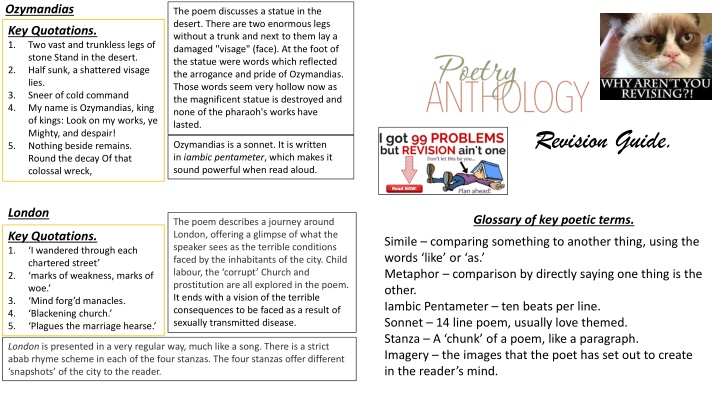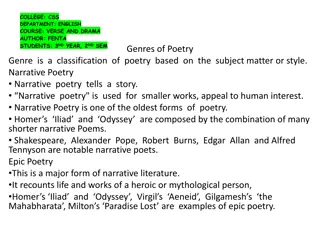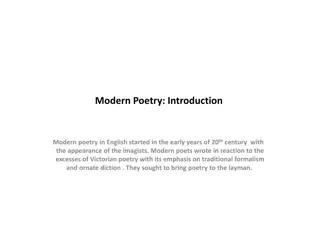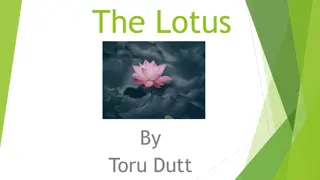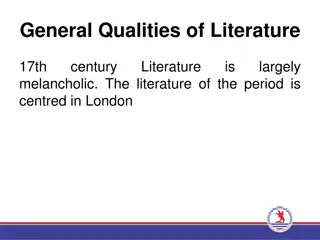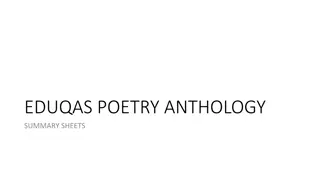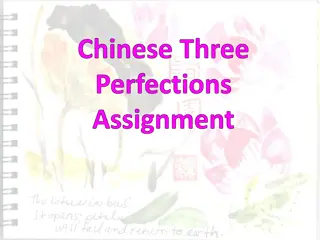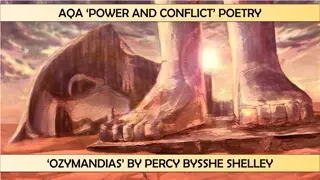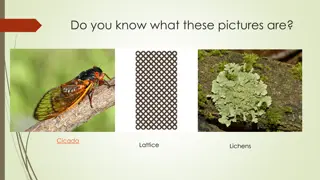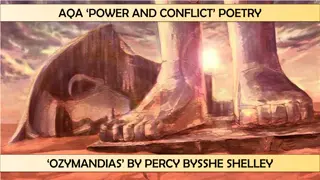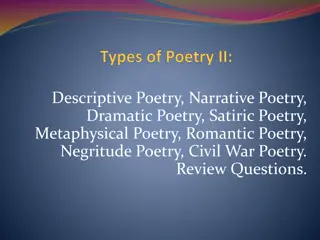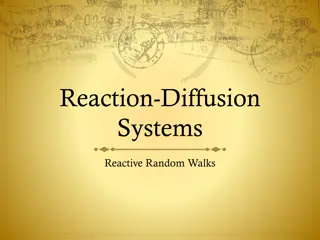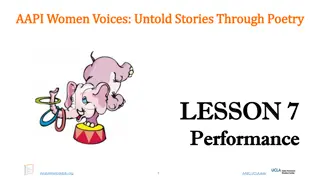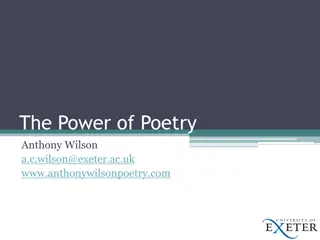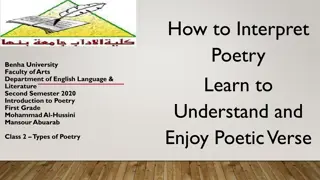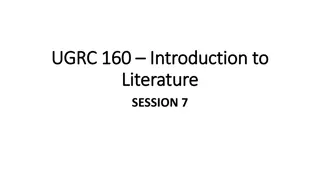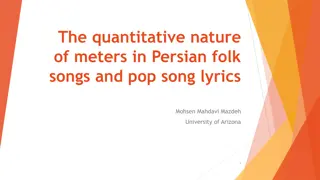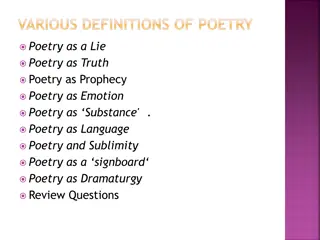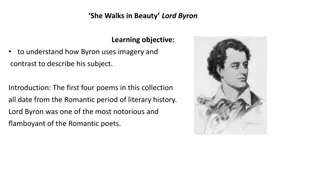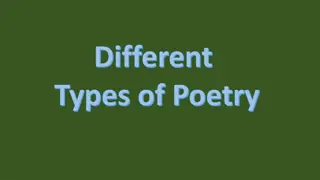Analysis of Classic Poetry: Ozymandias, London, Valentine, She Walks in Beauty
Delve into the themes and structures of classic poems including "Ozymandias," "London," "Valentine," and "She Walks in Beauty." Explore metaphors, imagery, and key quotations to uncover the deeper layers of meaning in these iconic literary works.
Uploaded on Jul 15, 2024 | 2 Views
Download Presentation

Please find below an Image/Link to download the presentation.
The content on the website is provided AS IS for your information and personal use only. It may not be sold, licensed, or shared on other websites without obtaining consent from the author.If you encounter any issues during the download, it is possible that the publisher has removed the file from their server.
You are allowed to download the files provided on this website for personal or commercial use, subject to the condition that they are used lawfully. All files are the property of their respective owners.
The content on the website is provided AS IS for your information and personal use only. It may not be sold, licensed, or shared on other websites without obtaining consent from the author.
E N D
Presentation Transcript
Ozymandias The poem discusses a statue in the desert. There are two enormous legs without a trunk and next to them lay a damaged "visage" (face). At the foot of the statue were words which reflected the arrogance and pride of Ozymandias. Those words seem very hollow now as the magnificent statue is destroyed and none of the pharaoh's works have lasted. Key Quotations. 1. Two vast and trunkless legs of stone Stand in the desert. 2. Half sunk, a shattered visage lies. 3. Sneer of cold command 4. My name is Ozymandias, king of kings: Look on my works, ye Mighty, and despair! 5. Nothing beside remains. Round the decay Of that colossal wreck, Revision Guide. Ozymandias is a sonnet. It is written in iambic pentameter, which makes it sound powerful when read aloud. London Glossary of key poetic terms. The poem describes a journey around London, offering a glimpse of what the speaker sees as the terrible conditions faced by the inhabitants of the city. Child labour, the corrupt Church and prostitution are all explored in the poem. It ends with a vision of the terrible consequences to be faced as a result of sexually transmitted disease. Key Quotations. 1. I wandered through each chartered street 2. marks of weakness, marks of woe. 3. Mind forg d manacles. 4. Blackening church. 5. Plagues the marriage hearse. Simile comparing something to another thing, using the words like or as. Metaphor comparison by directly saying one thing is the other. Iambic Pentameter ten beats per line. Sonnet 14 line poem, usually love themed. Stanza A chunk of a poem, like a paragraph. Imagery the images that the poet has set out to create in the reader s mind. London is presented in a very regular way, much like a song. There is a strict abab rhyme scheme in each of the four stanzas. The four stanzas offer different snapshots of the city to the reader.
Valentine Carol Ann Duffy. Cozy Apologia Rita Dove. Key Quotations. I could pick anything and think of you. Sure as shooting arrows to the heart. chain mail glinting, to set me free. Sweet with a dark and hollow center. it s embarrassing, this happiness. I fill this stolen time with you. Valentine describes a gift for a lover, such as you would give on Valentine s Day. It is an unusual present an onion. The poem explains why it is a powerful gift of love, much more than the clich d gifts. The onion becomes a metaphor for love it is a long lasting and honest gift. Waiting for a storm to hit, the speaker thinks about her partner. She pictures him as a knight in shining armour, protecting her. He's a vivid contrast, she thinks, to the 'worthless' boys she used to date. She's embarrassed by how content their cosy, ordinary lives have made them. Yet she draws comfort from filling the 'stolen time' resulting from the hurricane's approach with thoughts of Fred. Key Quotations. Not a red rose or a satin heart. It will blind you with tears like a lover. Its fierce kiss will stay on your lips. Platinum loops shrink to a wedding ring. The romantic imagery at the start of the poem rose and kissogram is starkly contrasted by non romantic words at the end. Knife and lethal, which makes love seem dangerous. Made up of three 10-line stanzas. Stanza one has five rhyming couplets, This rhyme scheme starts to break down in stanza two, as if reflecting the disruption of the oncoming storm. The poem is a first person narrative written in free verse there is no rhyming scheme. Carol Ann Duffy (born 1955) is a Scottish poet and fierce feminist. She walks in Beauty. Byron. Sonnet 43 Elizabeth Barrett Browning. In this poem, Byron admires a woman s beauty. There is clear sense of longing in the poem and the reader assumes that the object of his affections cannot be his. It is not just about her physical beauty, he also admires her mind and her eloquence. The speaker in the poem doesn t admit to having feelings of love until the very last line of the poem, and he admires the woman s innocence. This contrasts to his bad reputation and the scandals surrounding him. Lord Byron (1788-1824) famous poet known for his amorous lifestyle and brilliant use of the English language. Barrett Browning wrote this poem to her husband Robert Browning, who inspired a lot of her work. Key Quotations. She walks in Beauty like the night. So soft, so calm, yet eloquent. A mind at peace with all below. A heart whose love is innocent. Key Quotations. How do I love thee? Let me count the ways! I love thee freely, as men strive for Right, I love thee purely, as they turn from Praise; I love thee with the breath, Smiles, tears, of all my life! I shall but love thee better after death. Made up of 14 lines and a regular but flexible rhyme scheme. The word love is repeated for emphasis and love is compared to holiness lost saints. The way that the lines are broken up by punctuation at the end could represent breathlessness and passion. The poem is autobiographical and reflects the struggles that she went through to be with her true love, Robert Browning. The rhyme scheme of the poem is very controlled and regular it is perfect -like the woman. The poet uses rich and varied language, alliteration and assonance. 06/03/1806 29/06/1861
The Soldier Rupert Brooke. Dulce Et Decorum Est- Owen. Key Quotations. 1- Bent double, like old beggars under sacks 2- Men marched asleep 3- Gas! Gas! Quick, boys! 4- if you could hear, at every jolt, the blood Come gargling from the froth-corrupted lungs.. 5- The old lie: Dulce et Decorum Est Pro patria mori. Owen is recounting his fist hand experiences of fighting in WW1 in this poem. He describes the dreadful conditions of the battlefront and gruesomely depicts the death of a fellow soldier from a gas attack. It is an unflinchingly honest portrayal of war, opposite to pro-war, patriotic ideas of the time. Owen makes use of rhyme, mostly on alternate line endings. Irregular structure reflects life as a soldier. The soldier encapsulates the feeling of patriotism that was evident in British society at the start of WW1. It expresses the belief that it is an honourable thing to die for your country, and Brooke is prepared to die in battle. England is a key theme in the poem and the speaker clearly loves his country. It is worth noting that Brooke never saw the reality of battle he died on his way to fight. Key Quotations. 1- in some corner of a foreign field That is forever England . 2- A dust whom England bore, shaped, made aware . 3- A pulse in the Eternal mind 4- breathing English air 5- In hearts at peace, under an English heaven The poem is a sonnet, usually reserved for love poems it is Brooke s love poem for his country. Owen was killed in action. His mother received news of his death just as the end of the war was announced. Religious imagery England is like a heaven. Anti war Owen wanted the public to know the truth about the front line. Mametz Wood Shears. The Manhunt - Armitage. Mametz Wood was the scene of fierce fighting during the Battle of the Somme, one of the bloodiest battles of the First World War. The battle lasted five days. There were 4,000 casualties. The poem describes the battle field in modern times, with soldier s bodies being uncovered by farmers tending the land. The Manhunt is written from the perspective of the wife of a soldier who has sustained serious injuries at war and has returned home. The poem explores the physical and mental effects of living with injuries sustained when on active service in the armed forces. Key Quotations. 1. the frozen river which ran through his face 2. the damaged porcelain collar bone 3. the parachute silk of his punctured lung 4. feel the hurt of his grazed heart 5. every nerve in his body had tightened and closed. Key Quotations. 1- For years afterwards the farmers found them.. 2- the wasted young 3- twenty men buried in one long grave 4- in boots that outlasted them 5- a broken mosaic of bone Sheers uses imagery to show how death in the First World War has been literally and metaphorically buried. Written in very plain, almost prosaic (everyday) language. There is a very subtle use of sound throughout to show the noises of war. The final image : the bones singing. The poem is made up of a series of couplets, mostly unrhymed. This creates a sense of fragmentation, which matches the feelings of the soldier's wife as she seeks to understand the man her husband has become. Written in 2005, looking back at how we remember the First World War and the legacy that war leaves behind.
A Wife in London Hardy Death of a Naturalist Key Quotations. 1. All year the flaz dam festered in the heart 2. best of all was the warm thick slobber of frogspawn. 3. The fattening dots burst. 4. Angry frogs invaded. 5. The great slime kings were gathered there for vengeance. Death of a Naturalist is both a description of Heaney s experience with nature as a boy, and a metaphor for the loss of his childhood innocence, as he looks back wistfully at his youthful naivety. He is fascinated by the frogspawn and tadpoles of the flax-dam , but becomes repulsed by a horde of croaking frogs in their maturity. The poem describes a wife receiving news of her husband who has died in a battle. It is a poem about grief and love. Fog swirls round the streets. Pathetic fallacy is used to create an ominous atmosphere the reader knows that something bad is going to happen. Ironically, after she has learned that he is dead, she receives a letter from her husband in which he speaks of his excitement of when he will next see her and the things which they will do together. Key Quotations. 1- he-has fallen- in the far South Land. 2- the fog hangs thicker. 3- His hand, whom the worm now knows. 4- page-full of his hoped return. 5- Flashed news in her hand. The poem is split into two sections the tragedy and the irony. The second half of the poem shows how her life has changed after the death of her husband. The poem is written in iambic pentameter. A lot of childhood imagery is used to convey the youth and innocence of the speaker. Seamus Justin Heaney, was an Irish poet, and the recipient of the Nobel Prize in Literature Afternoons - Larkin Throughout the poem, the speaker addresses autumn as if it were a person. In the first stanza, he notes that autumn and the sun are like best friends plotting how to make fruit grow and how to ripen crops before the harvest. He tells us about the bees that think summer can last forever as they buzz around the flowers. But the speaker knows better. The second stanza describes the period after the harvest. In the third stanza, the speaker notes that the music of spring is a distant memory, but that autumn's music is good too. All of the sights and sounds produce a symphony of beauty. To Autumn - Keats Afternoons is a very melancholy poem, about the inevitability of change and the passing of youth. The poem talks about the challenges of growing up and having children. The poem discusses parenthood how priorities have changed and there are responsibilities to face. The couples in the poem have been replaced by younger couples who go to their old courting places. Key Quotations. 1. Close bosom-friend of the maturing sun; 2. later flowers for the bees, Until they think warm days will never cease 3. Where are the songs of Spring? Ay, where are they? John Keats (1795-1821) was an English Romantic poet. He was one of the main figures of the second generation of Romantic poets, along with Byron and Shelley. Key Quotations. 1. Summer is fading 2. young mothers assemble. 3. Our Wedding lying near the television. 4. expect to be taken home 5. something is pushing them to the side. The structure of the poem is simple; there are three stanzas with eight lines in each. Philip Arthur Larkin (9 August 1922 2 December 1985) was an English poet, novelist and librarian.
Hawk Roosting Ted Hughes. The Prelude Key Quotations. 1. The wilight blaz d. 2. We hiss d along the polish d ice. 3. Woodland pleasures. 4. Every icy crag tinkled like iron. 5. An alien sound of melancholy. 6. The orange sky of evening died away. The poem is written from the first person narrative of a hawk, who is at the top of the food chain in his wood. It discusses power. The hawk believes in himself absolutely. The poem uses a lot of imagery related to death and evolution. The hawk is a determined character who will not allow anything or anyone to stand in his way. We could interpret the poem as literally being about a hawk, or the hawk could be a metaphor for a person in absolute power a dictator. Key Quotations. 1. I sit at the top of the wood. 2. Rehearse perfect kills and eat. 3. Now I hold creation in my foot. 4. I kill where I please 5. The allotment of death. 6. I am going to keep things like this. The prelude is a very long, autobiographical poem, showing the spiritual growth of the speaker. In the poem, Wordsworth recounts his childhood experience of skating on a frozen lake at twilight. His vocabulary and imagery is vivid and powerful. The sky is orange and the evening blaz d. He feels not just happiness but rapture. In the second section, he leaves the pack and is alone with nature. In the third section, he personifies nature as spirits, which haunt him. The poem is made up of four line stanzas controlled, like the hawk is controlling his environment. William Wordsworth (1770-1850) is one of the most famous poets in the history of English Literature. As Imperceptibly as Grief. In Emily Dickinson s poem As imperceptibly as Grief, Dickinson uses beautiful words to show her complete distress.. Dickinson write about Summer as if Summer is a symbolism for happiness. Dickenson writes this poem to represent her own emotions and struggles.. Her words provide a sense of beauty in the darkness. Living Space Imtiaz Dharker The poem describes a ramshackle living space, with its lack of 'straight lines' and beams 'balanced crookedly on supports'. Imtiaz Dharker has explained that the poem describes the slums of Mumbai, where people migrate from all over India in the hope of a better life. The slum areas are living spaces created out of all kinds of found materials: corrugated sheets, wooden beams and tarpaulin. In this poem she celebrates the existence of these living spaces as a miracle. Key Quotations. 1. Not enough straight lines 2. Beams balance crookedly. 3. Nails clutch at open seams. 4. Eggs in a wire basket. 5. Bright, thin walls of faith. Key Quotations. 1. The summer lapsed away. 2. Sequestered afternoon. 3. courteous yet harrowing grace. 4. As guest that would be gone. 5. Our summer made her light escape into the beautiful. Living Space is written in one long thin stanza with 22 short lines. The poem leads up towards the final line when summer is gone there is a finality to the end of summer which is comparable to the finality of death. Imtiaz Dharker is a British poet, artist and documentary filmmaker. She has won the Queen s Gold Medal for her English poetry. Emily Dickinson (1830 1886) was an American poet. She lived most of her life in solitude as a recluse.
